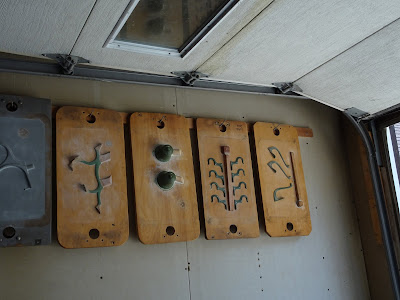US Bells is a company in Prospect Harbor, Maine, about an hour from
us. They make sand cast bells and other
items.
Their ad says if you are there when they are pouring, you can
watch. We didn’t know when they poured
but decided to stop by anyway and check it out.
We got lucky and were told they would be pouring in about 30 minutes.
The bells are made of silicon bronze which is 4% silicon, 1%
manganese and the balance copper. It’s
durable and highly resistant to corrosion.
Most importantly, the bells ring with a strong, pure tone that is unique
to bronze.
We saw many dies for the bells and various hardware. They are mounted on a pattern board, called a
match plate. As many copies are mounted on
a pattern board as will fit within the molding frame, called a flask.
The
pattern is placed in the molding frame which rests on the molding machine.
The
"jolt-squeeze" molder has a large air cylinder which will compact the
sand against the pattern creating a hard mold. Sand is shoveled into the flask,
covering the pattern and rammed or squeezed until the mold is full and packed
hard.
Molding
sand has just enough clay and water mixed in to enable it to bond together with
enough strength to retain the impression from the pattern even after the
pattern is removed.
This
is what the sand looks like that has never been used.
This
sand has been used for about 40 years!
The
molder will remove the pattern, cut the "spru hole" through the top,
blow away any loose sand from the mold faces, and then close the mold and clamp
it or weight it for pouring.
(The
"spru hole" is like a funnel to direct the molten bronze into the
mold cavity. The bronze is poured down the spru hole until the mold fills to
the top..
Here
are todays sand molds all set up and ready for pouring.
The
first two are molding frames holding one bell mold each. The rest of the sand molds are for various
hardware. There are weights on top of
the molds and the first molding frame has a completed bell sitting on top of
it. This is the bell they will be
molding today.
While
we waited, we were able to see the employee melting the bronze.
We
were told it was time to pour. We were the only
visitors here, so we didn’t have any problems getting good looks at the
process.
It
takes two people to make a pour. They
suited up with protective gear.
The
temperature of the bronze was taken.
The crucible containing 90 pounds of molten bronze is removed
from the furnace.
The metal must be poured smoothly but quickly into each mold to assure the castings do not ‘freeze’ before they are full.
The last bit of bronze is poured into a mold to be re-heated
and used later.
Sand is on the floor under the molds to catch any hot bronze that might come out. Today one of the molds did spring a leak.
The bell molds take a couple of minutes longer to harden.
After removing the weights and ‘jackets’, the molds are
broken open to reveal the new castings.
Curious about the price? They are not cheap. The bells made today (8”) cost $1,600. 5” wind bells are $185.
The very large bell at the beginning of the post is $6,500
and can have custom imprints.
This is a very small, family owned, company. Richard Fisher (the father) started making
bells in 1970. In 1975 he and his wife, Cindy,
moved to Maine. In 1982 they built the
original foundry building. They have
four sons. I don’t know if all the sons
work in the business, but we met Tim while we were walking around. Tim is a woodworker. His wife, Liza, makes pottery. The mother, Cindy, sews quilts. There are an additional 3 employees.
We talked to Tim and Liza for quite a while. Tim is in charge of the woodworking part of
the business. This bird pattern is his
design.
Liza (Tim’s wife) told us a little about her pottery.
This was an awesome tour! Most of the time they pour Monday - Wednesday at 11:30. It is worth a stop.









































That is quite a process and so much work for what seemed a small bell. Thanks for documenting it!
ReplyDeleteWow. What a cool tour. We have added it to our list! Thanks for sharing!
ReplyDelete